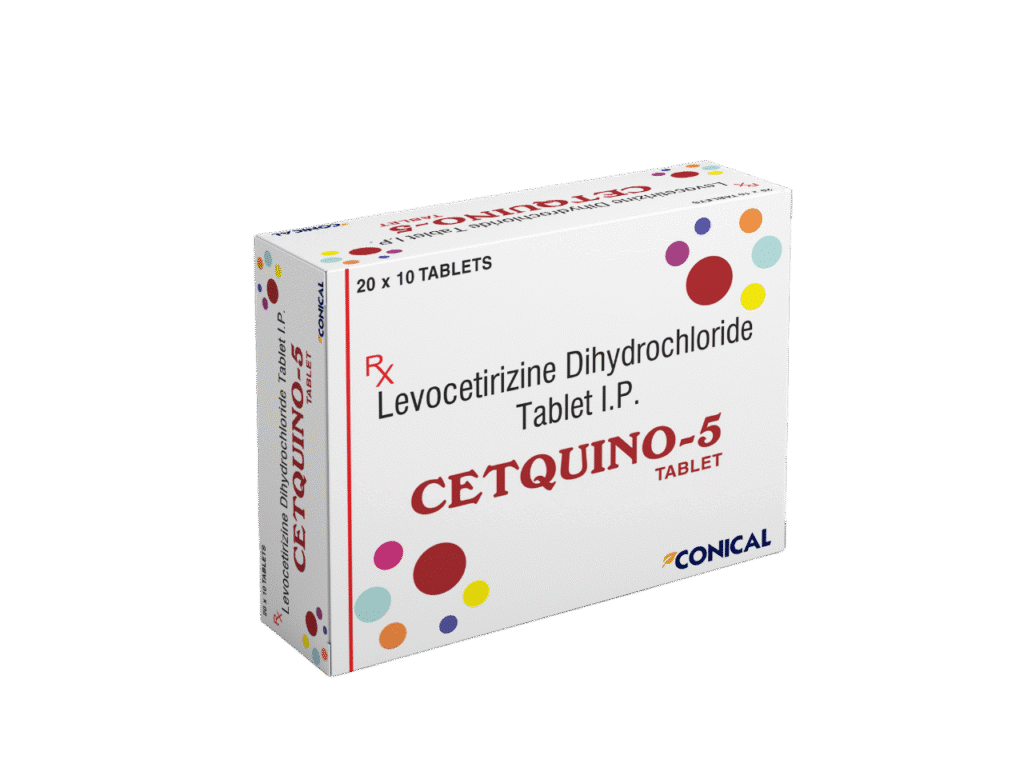







What are the uses of levocetirizine dihydrochloride tablets?
Levocetirizine Dihydrochloride Tablet is a powerful antihistamine that helps relieve allergy symptoms by blocking H1 receptors—the spots where histamine (the chemical that causes sneezing, itching, and swelling) attaches.
Precautions to Keep in Mind While Taking Levocetirizine Dihydrochloride Tablet
Children
Lactose Warning
Pregnancy and Breastfeeding
Pregnancy
Breastfeeding
Dosage and Directions for Levocetirizine Dihydrochloride Tablet
Adults and Teens (12 years and older)
Older Adults
People with Kidney Issues
Your doctor may adjust your dose depending on how well your kidneys are working.
This is measured using a test called eGFR (estimated glomerular filtration rate).
|
Group |
eGFR (ml/min) | Dosage and frequency |
|
Normal renal function |
≥ 90 |
1 tablet once daily |
| Mildly decreased renal function | 60 – < 90 | 1 tablet once daily |
| Moderately decreased renal function | 30 – < 60 | 1 tablet once every 2 days |
| Severely decreased renal function | 15–< 30
(not requiring dialysis) |
1 tablet once every 3 days |
| End-stage renal disease
(ESRD)—patients undergoing dialysis |
< 15
(requiring dialysis treatment) |
Contraindicated |
Dosing for Children and Special Conditions
Children with Kidney Problems
Liver Problems
Children Aged 6 to 12 Years
Children Aged 2 to 6 Years
Some people may experience these side effects of levocetirizine dihydrochloride tablets . The exact chances of these happening are not known, but it’s important to stay aware:
Allergic Reactions
Changes in Appetite
Mental Health Changes
Nerve & Brain Effects
Ear & Eye Problems
Heart & Breathing Issues
Stomach Troubles
Liver or Urine Issues
Skin Reactions
Muscle & Joint Pain
Other General Symptoms
Store in a cool & dry place; protect from light.
Keep out of reach of children.
20 × 10 Alu/PVC Blister
Levocetirizine Dihydrochloride Tablet is available in an Alu/PVC blister of 10 tablets. Such 20 blisters in a unit carton with a package insert.
Contact us directly to receive full information on the product, the formulation, the science behind it, stability data, and more. Our Business Development Manager is a click away.
Questions are useful tools, they open lines of communication; give us information; improve interactions, facilitate analysis, and many more.
A pharma CMO is a special kind of an organization, offering contract manufacturing services to pharmaceutical companies for various kinds of drug formulations.
Reduce overall costs and time to market :
Contract manufacturers already have the needed infrastructure and technical staff, so working with a CMO or CDMO can decrease the cost of manufacturing your pharmaceutical products.
Scalability and flexible production capacity :
You can produce what you need when you need it without worrying about excess capacity. Additionally, CMOs understand the importance of quality and compliance, so you don't have to sacrifice safety for scalability.
Save on upgrading and maintaining equipment :
If you have your manufacturing facility, you’ll have to pay to upgrade your equipment as technology advances—which can get expensive. A CMO/CDMO’s only function is to make and distribute products, so part of their core business responsibility is to update their equipment whenever needed and perform maintenance.
Ease supply chain issues :
During the pandemic, there were several instances of supply chain issues, including medicine shortages. CMOs are generally better equipped than startups to handle a supply chain crisis.
Bandwidth to focus on core competencies
When your company resources aren’t directly allocated to manufacturing and distribution, you have more time to focus on other tasks, like marketing your new drug, researching, or working on drug discovery.
We have 7+ manufacturing sites with a minimum of WHO GMP certification and other country-specific approvals like NAFDAC approved, PPK Kenya Approved, TFDA Tanzania Approved, EU-GMP Approved.
We have below manufacturing capacity:
For Tablet, Capsule, and soft gel: up to 1 million units per shift
For Syrup: up to 0.05 Million per shift
For Ampoule and Vial: up to 0.1 million units per shift
For Ointment and Cream: up to 0.1 million units per shift
For Suppository: 0.1 Million units per shift
